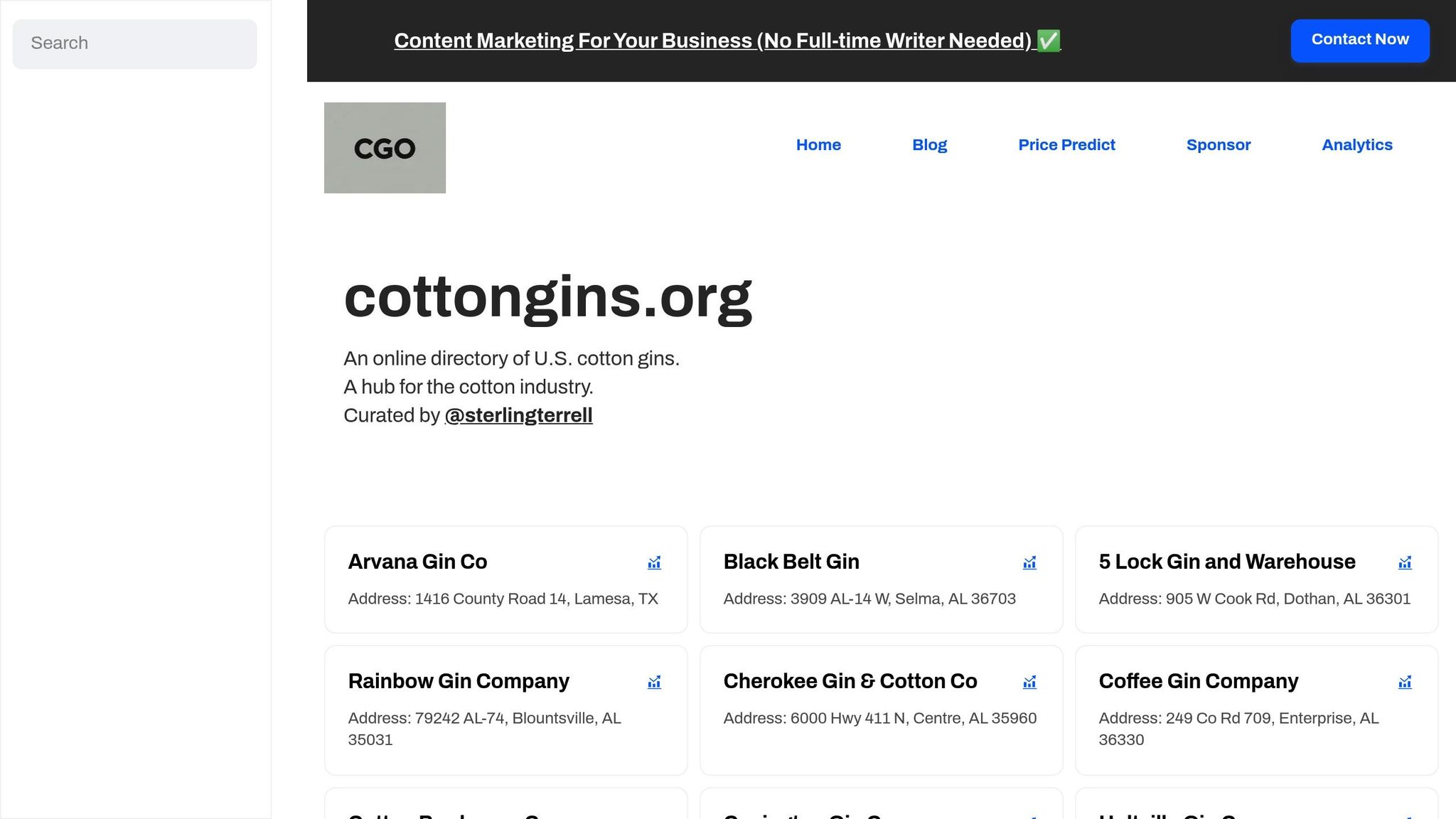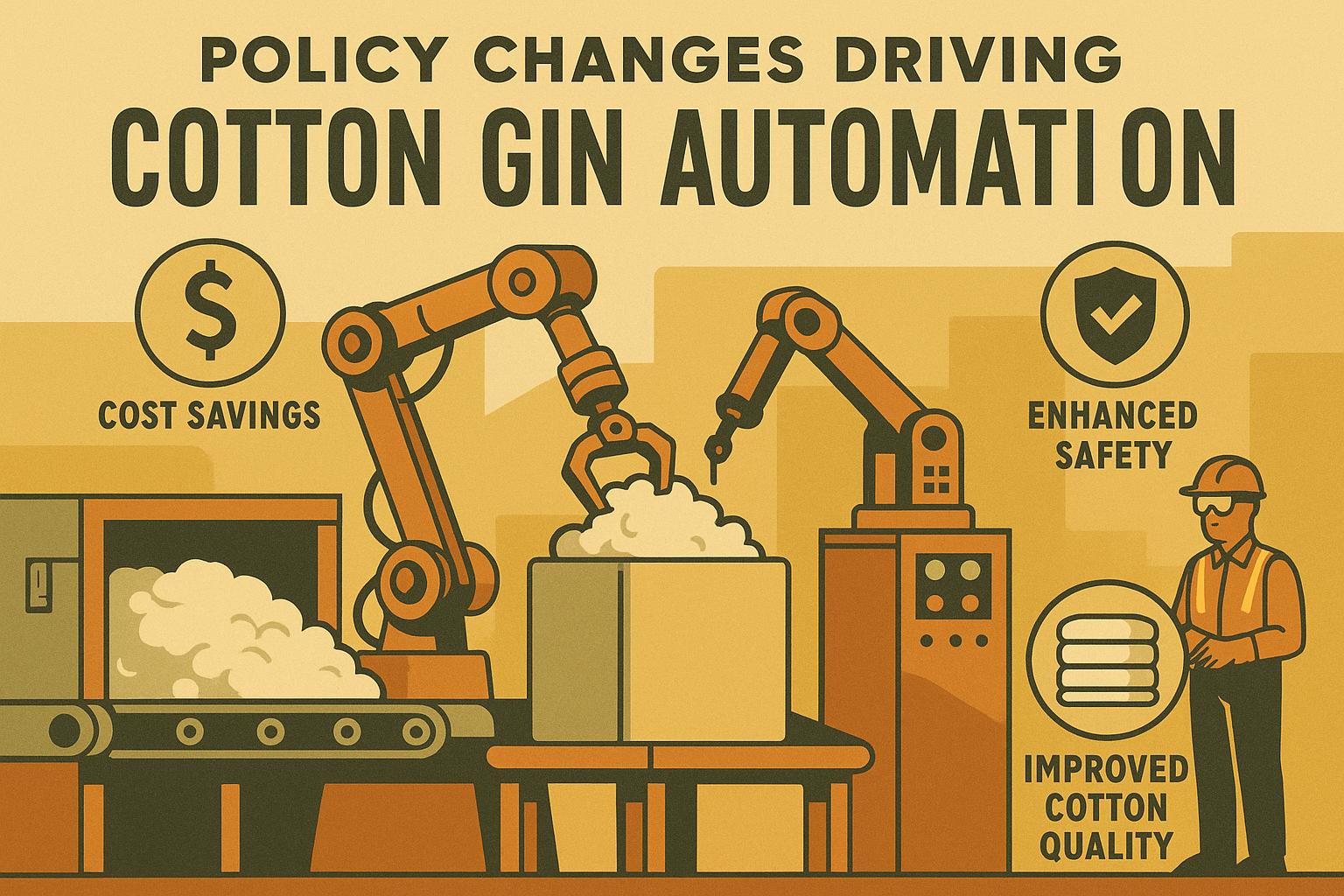Cotton farmers often face insurance claim disputes that can delay payments and add stress. These conflicts typically arise from disagreements about farming practices, exclusions for manmade damage, or eligibility requirements. The key to avoiding these issues lies in maintaining detailed records, understanding policy terms, and meeting USDA standards.
Key Takeaways:
- Good Farming Practices (GFP): Claims may be denied if farming practices don't meet insurer standards. Farmers can appeal decisions through administrative reviews or courts.
- Manmade Damage: Insurance often excludes losses caused by human actions, such as pesticide drift. Quick documentation and formal complaints are essential.
- Policy Basics: Multi-Peril Crop Insurance (MPCI), STAX, and SCO are common policies, but each has specific rules and exclusions.
- Resolving Disputes: Options include mediation, arbitration, or formal reviews. Strong record-keeping is critical for success.
Tip: Tools like cottongins.org help verify processing records, strengthening your claim. Always document farming activities, crop damage, and communication with insurers to avoid delays.
Mr. Malay Poddar talks about Claims Settlement in PMFBY and how it has helped farmers.
Cotton Crop Insurance Policy Basics
Getting a handle on the basics of cotton crop insurance can save a lot of headaches down the road. The federal crop insurance program offers several options to help cotton farmers manage risks, but each comes with specific rules and conditions that can sometimes lead to misunderstandings. Knowing the different policy types is a good starting point before diving into coverage limits and exclusions.
Types of Cotton Insurance Policies
Multi-Peril Crop Insurance (MPCI) is the backbone of federal cotton insurance. Approved by the USDA, this policy shields farmers from natural disasters like drought, hail, frost, wind, excessive moisture, insects, and disease. It also includes federal subsidies to help with premiums.
Stacked Income Protection Plan (STAX) offers county-level coverage specifically for upland cotton producers. It’s designed to cover shallow losses by addressing the gap between expected county revenue and actual revenue. STAX can be used on its own or as a supplement to traditional crop insurance.
Supplemental Coverage Option (SCO) is an add-on that covers the deductible of a primary policy. However, it must be purchased alongside a traditional crop insurance plan.
The way these policies interact with other USDA programs can sometimes cause confusion, especially when farmers aren’t clear on how program rules overlap.
Coverage Limits and Common Exclusions
Cotton crop insurance has its limits and exclusions, and these can sometimes catch farmers off guard when filing claims. One major exclusion is related to marketing - crop insurance won’t cover losses due to an inability to sell a crop unless the loss is tied to physical damage from an insurable event.
Conservation compliance is another big factor. Farmers must follow conservation practices on highly erodible lands and avoid converting wetlands to cropland. Violations can result in losing insurance support entirely.
Replanting payments also come with restrictions. For example, payments may not apply if planting occurred before the earliest allowed date, if a payment has already been received for the same acreage, if appraisals show production will exceed certain thresholds, or if replanting isn’t practical.
Farm valuations can be tricky too, as they involve variable factors that influence coverage amounts and expected production levels. These complexities highlight the importance of understanding policy details to avoid surprises.
Policy Eligibility Requirements
Meeting eligibility requirements is critical, and good record-keeping plays a big role in staying compliant. For instance, upland cotton farmers enrolled in PLC or ARC programs can’t use STAX for any upland cotton acres on the same farm. Similarly, if base acres are enrolled in ARC, SCO cannot be purchased for the same crop on that farm.
Farmers also need to follow USDA rules for field preparation, watering, and harvesting. Failing to meet these standards can result in losing crop insurance coverage entirely, which makes thorough documentation of farming practices essential.
Conservation efforts go beyond the basics. Farmers must maintain conservation standards on highly erodible lands and comply with the Sodbuster and Swampbuster provisions, which prohibit converting wetlands to farmland. These efforts are necessary to qualify for federal premium subsidies.
Since these requirements are interconnected, they can create unexpected coverage gaps. Farmers need to fully understand how their choices in USDA programs might impact their insurance coverage before making decisions.
Common Cotton Insurance Claim Disputes
Even with a solid understanding of policy basics, disputes over cotton insurance claims are all too common. These conflicts can slow down payments and add financial strain, especially during tough times. Knowing where disputes typically arise can help farmers prepare better documentation and steer clear of common traps. Let’s break down some of the key areas where these disagreements happen.
Good Farming Practices Disputes
One of the most contentious issues in cotton insurance claims revolves around "good farming practices" (GFP). Insurance providers often deny claims if they believe a farmer hasn't adhered to practices widely accepted by agricultural experts. For instance, in 2020, a Texas organic cotton farmer named Owen had his claim denied because his organic farming plan was used as a benchmark for GFP. A ruling later clarified that while organic plans can reflect certain practices, they don't define GFP comprehensively. This led the Federal Crop Insurance Corporation (FCIC) to adjust the Common Crop Insurance Policy, removing references to organic plans in GFP evaluations.
Another ongoing case involves Farmer Miller, who grows both peanuts and cotton. As of July 14, 2025, Miller is appealing a summary judgment in the Fifth Circuit U.S. Court of Appeals. Federal regulators had determined that he failed to meet GFP standards. Oral arguments for this case are scheduled for August 5, 2025.
Farmers who face unfavorable GFP evaluations have options. They can contest these findings through administrative proceedings, arbitration, or even take the matter to court.
Manmade Damage Exclusions
Another common area of conflict arises from exclusions related to manmade damage. Federal crop insurance typically does not cover losses caused by human activities, which can create disputes when the source of crop damage is unclear. A frequent example is chemical drift from nearby properties, where pinpointing the timing and source of pesticide damage becomes tricky.
If you suspect pesticide injury, it’s crucial to act fast. Reach out to a county Cooperative Extension agent immediately to confirm off-target pesticide damage. Additionally, file a formal complaint with your state’s pesticide regulatory agency within 15 to 30 days of the suspected incident. This ensures the damage is assessed while evidence is still fresh.
To strengthen your case, gather the following documentation:
- Location and timeframe of the damage
- Photographs showing plant injury
- Weather conditions during the suspected incident
- Details about the pesticide applicator, if known
Because federal crop insurance usually excludes pesticide damage, farmers may need to explore other avenues. These include filing private crop insurance claims, negotiating settlements with the applicator, or pursuing legal action.
sbb-itb-0e617ca
How to Resolve Cotton Insurance Claim Disputes
Resolving disputes over cotton insurance claims often involves mediation, arbitration, or formal reviews. Choosing the right approach depends on the specifics of your case, and preparation is key to success.
Mediation and Arbitration Processes
Mediation is a collaborative process where you and your insurance company work with a neutral third party to find a mutually agreeable solution. It’s usually quicker and less expensive than going to court. The mediator doesn’t make binding decisions but facilitates productive discussions between both parties.
Before entering mediation, gather everything you’ll need to support your case. This includes your policy documents, claim forms, evidence like photos and invoices, and a detailed record of all communication with your insurer. Be ready to provide clear, factual information to justify the amount of your claim.
When selecting a mediator, look for someone with expertise in insurance law, who is impartial and communicates clearly. Make sure the insurance company’s representative at mediation has the authority to settle the claim.
Arbitration is a more formal process than mediation and results in a binding decision. The arbitrator reviews the evidence and issues a ruling that both parties must accept, effectively waiving the right to appeal.
Whether you choose mediation or arbitration, it’s vital to thoroughly review your insurance policy. Understand its coverage limits, exclusions, and any dispute resolution procedures it specifies. Consulting an attorney experienced in insurance disputes can also be helpful. They can assess your claim’s validity and assist in preparing a clear, written summary of your position.
If these methods don’t resolve the issue, you may need to consider formal reviews.
Court and Administrative Reviews
If mediation and arbitration fail, formal reviews might be your next step. Administrative reviews often involve filing an appeal with the appropriate agency, which requires strict adherence to deadlines and procedural rules. If you suspect your insurance company acted in bad faith or administrative reviews don’t resolve the issue, you might need to take the matter to federal court. However, litigation can be both time-consuming and expensive, so it’s crucial to evaluate your claim’s strengths and potential defenses before proceeding.
Documentation and Record-Keeping
Good record-keeping is critical for resolving disputes and can often be the deciding factor in your case. Start maintaining detailed records as soon as you purchase your policy - not just when a problem arises.
Key documents include your policy paperwork, all correspondence with the insurance company, photos of your crop conditions throughout the growing season, weather records, receipts for inputs, and logs of your farming practices. If damage occurs, document it immediately with photos, written descriptions, and, if possible, third-party assessments.
Communication logs are particularly important. Keep a record of every phone call, email, and meeting with your insurer. Note the date, time, names of those involved, topics discussed, and any promises made. These records can be invaluable during mediation, arbitration, or court proceedings.
Organize your documentation so it’s easy to access. Maintain both physical and digital copies, with backups, to ensure you don’t lose critical evidence. Being well-prepared can make all the difference in resolving your claim.
Using Directories and Resources for Claims Support
When it comes to cotton insurance claims, having accurate documentation of processing locations can make all the difference. This documentation serves as key evidence to verify your actual production history and the validity of your claim.
Cotton processing records, which are considered standard business documents, can be pivotal during legal disputes. These records are not protected under attorney work product privilege, making them accessible and highly influential in claim disputes. By maintaining a clear trail of processing documentation, you can strengthen your case, especially when disputes over production history arise. This approach works hand-in-hand with good record-keeping practices and other resolution strategies.
Finding Cotton Gins with cottongins.org

To strengthen your documentation, cottongins.org offers a directory that helps farmers locate processing facilities across major cotton-producing states. This tool is a practical resource for identifying and documenting where your cotton was processed, which is critical for supporting your insurance claims.
When filing a claim, accurate processing location records help establish your actual production history (APH). Insurers rely on this information to determine expected yields for insured units. By using cottongins.org to pinpoint the specific gin where your cotton was processed, you create a verifiable paper trail that supports your production records.
The directory provides detailed information, including addresses and contact details for each facility. This makes it easier to maintain thorough records of your cotton’s journey through processing. Such documentation becomes especially valuable when insurance adjusters need to verify the timing or extent of crop damage. Clear evidence of when and where your cotton was processed can help resolve disputes quickly and effectively.
For farmers facing claim challenges, the directory also acts as an independent verification source that insurance companies can reference. This third-party documentation adds credibility to your claims, reducing the risk of delays or insufficient compensation due to incomplete records.
Business Visibility Through Sponsorship
Beyond documentation, sponsorship opportunities on cottongins.org can enhance the visibility and reputation of cotton gin operators. By participating in sponsorship programs, gin facilities can increase their visibility within the farming community and position themselves as reliable processing partners.
Enhanced visibility makes it easier for farmers to identify reputable facilities, which, in turn, strengthens the documentation chain needed for insurance claims. When farmers work with well-documented and established facilities, it adds credibility to their production records. Insurance adjusters are more likely to trust documentation from facilities that are professionally recognized and easy to verify through directories like cottongins.org.
To maintain trust and reliability, gin operators should ensure their listings on cottongins.org are always up-to-date with accurate contact and operational details. Keeping this information current not only helps farmers maintain precise records but also demonstrates the facility’s commitment to professionalism - something insurance companies value during claim reviews.
Key Takeaways
Here’s what you need to know about handling cotton insurance claim disputes effectively:
Disputes often stem from disagreements about farming practices, exclusions for manmade damage, irrigation problems, or the timing of damage. By understanding these common issues, farmers can prepare stronger documentation and avoid delays in processing claims.
Records from cotton gins play a crucial role in establishing actual production history (APH). These standard business documents provide reliable data for yield and payout calculations and can significantly support claims during legal reviews.
Farmers have multiple options for resolving disputes, including mediation, arbitration, and administrative reviews. The National Appeals Division offers an additional avenue for addressing conflicts with insurance adjusters, providing a structured process for resolution.
Using tools like cottongins.org can enhance your claim by offering verified processing records. This resource helps farmers maintain accurate documentation of processing locations, creating a clear and traceable record that strengthens insurance claims. The directory also provides detailed information about facilities, such as addresses and contact details, simplifying the process of tracking your cotton's journey.
For cotton gin operators, sponsorship opportunities on platforms like cottongins.org increase their visibility within the farming community. This higher profile helps farmers identify trusted facilities, which in turn adds credibility to their production records during claim evaluations.
To improve your chances of a successful claim, be proactive. Keep thorough records of your farming practices, equipment upkeep, and processing locations. Leverage resources like cottongins.org to verify facility information and build a solid documentation trail. And before considering litigation, explore all available resolution methods to settle disputes efficiently.
FAQs
How can cotton farmers ensure their farming practices meet insurance requirements and avoid claim issues?
To satisfy insurance guidelines and steer clear of claim complications, cotton farmers need to keep thorough records of their farming activities. This includes tracking planting dates, fertilization schedules, pest control efforts, and harvest timelines. These records not only prove adherence to policy terms but also highlight sound farming practices.
Maintaining open communication with crop insurance agents is equally important. Regular check-ins help clarify policy requirements and ensure farming operations align with coverage terms. By documenting everything consistently and addressing potential concerns early, farmers can greatly lower the chances of claim denials or disputes.
What steps should farmers take to document pesticide drift damage for an insurance claim?
Farmers dealing with pesticide drift damage should make sure to document everything thoroughly. Start by noting the date, time, and weather conditions at the time of the incident. Be specific - include details like wind speed, direction, and temperature. These factors can play a big role in understanding how the drift occurred.
Also, gather information about the pesticide application itself. Record the product name, application rate, and the type of equipment used. These details can be crucial for identifying the source.
Don’t forget to take clear photos of the damaged crops. Visual evidence can be powerful. Additionally, collect plant samples and send them for lab testing. This step can confirm the type of damage and link it to the pesticide in question.
Keeping your records detailed and well-organized will make it much easier to prove the cause and scope of the damage, especially if you need to file an insurance claim.
How can resources like cottongins.org help reduce disputes in cotton insurance claims?
Resources like cottongins.org offer a centralized hub for verified details about cotton gin locations and operations. This kind of reliable, up-to-date information helps improve the accuracy of insurance claims by reducing errors and misunderstandings that could otherwise lead to disputes.
By streamlining access to trustworthy data, this resource not only aids in better risk assessment but also encourages a smoother claims process. The result? Greater transparency and stronger trust between insurers and claimants.


